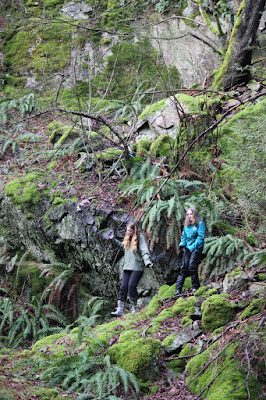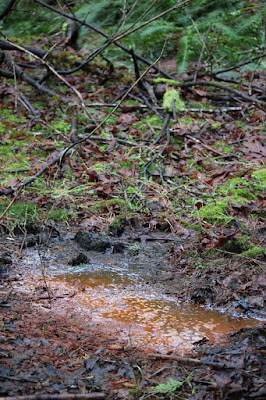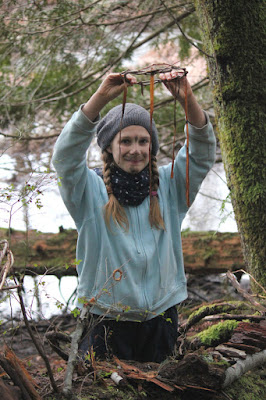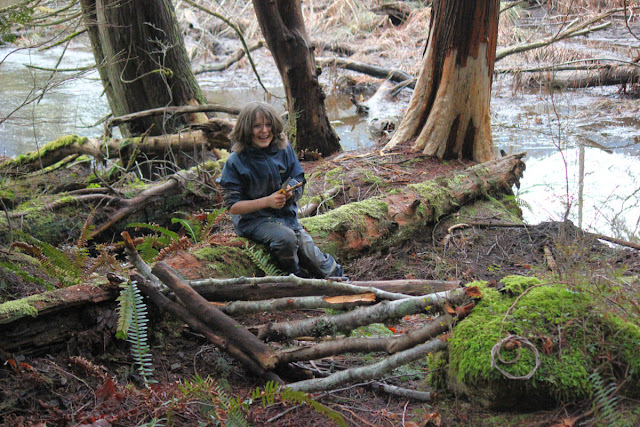 |
| Photo by Kim Weedmark. |
My friend gave me this photo a few days ago. She came along as a parent helper with her older son's Wild Art outing, and she brought her younger sons along, too. This is me dumping some of the creek out of one of her sons' boots, as he said "you need to dump it out, but not on my leg. You need to dump it over there."
When I saw this photo I felt so happy. That's something I can almost never say about a photo of myself, so when it happens it feels amazing. And I had to think for a while about why this moment was so wonderful to me, or this photo of me in my muddy rain gear dumping out a child's boots.
Then I realized: It's not just muddy rain gear. That is
the muddy rain gear that I wear when I take people adventuring in the wet wilderness. That mud is my badge of joy. It's not just any water. That is some of
the creek that filled up so much it ran out and filled the trails in the meadow. That is the creek these kids know as part of their home, and I have had the enormous privilege of sharing their experiences of getting to know it. It's not just any child - it's a boy I've been adventuring with many times, and I adore him. There are moments of his wonder-filled face etched in the crevices of my brain, so that when I walk through certain areas I will think of him, just like when I paint a certain way I will think of other people I've painted with, or when I climb a certain tree I will think of the people who first climbed that tree with me. Now when I dump out boots I will remember his deliberate instructions to not dump it on his leg - always.
I have had difficulty finding work for a few months, and on top of the financial woes that situation brings, I've been feeling worthless. It's easy to slip into worthlessness when mothering. Even though you know your presence is needed, it doesn't always feel that way. And when your kids are as old as mine are, and they don't even really need you to cook for them, they want rides but you know it's better for them to transport themselves, they don't particularly want your loving advice, and you don't want to alienate them with criticism, but you find yourself doing it anyway... then you might become lost. I was so lost. And as my employment dried up over the last year it felt like the world had conspired to remind me that I was unneeded. I couldn't even bring home an income, let alone be of value to somebody.
Luckily I did have a job lined up, and it began last week. It's only once (sometimes twice) per week, but it's my work. It's a job I've created out of my own passion and I love my work. I love going out in the woods and beaches and meadows and creeks and just launching myself full-force into impassioned exploration and discovery. I love coming back to a warm cup of tea and my richly inspiring studio and either creating what my heart feels, or sharing a wonderful material exploration with others. I
love sharing these experiences with other people. I
love my work! And now I realize: I love that I
have work. I love that there is something I can do that brings the joy I experience into reach for other people. I love that even if it's just because somebody needed his boots dumped out, I made a difference.
There's nothing like a few months without plumbing or potable water to make you realize how much you treasure the clean water. There's nothing like returning to work after a time of employment drought to remind you that you deserve to exist in the world.
Thank you, world, for making a space for me and the work I love to do. Thank you, parents, for trusting me to take your kids gallivanting in the wild and in the art. Thank you, adventurers young and adult, for tromping into wildernesses with me. And thank you Kim, for taking the photo that unlocked all this gratitude.
I guess I needed the opportunity to work again to renew my spirit. But I also needed some extra time to process what had happened. Until I saw this photo I didn't even realize what had been missing in my life. I guess more time is always a good thing. My young friend gave me some advice on that, too:
"You need to bring the clock with more minutes. How many minutes does your clock have?"
"Sixty," I replied, uncertainly.
"Next time you should bring the one with a hundred."
.





 The younger group returned to the forest village they'd begun making the week before, and carried on creating things to sell at their shops and restaurants. One group led a tour to a beaver lodge, and later became petty criminals, robbing the shops and calling the 'police' on each other. We discovered some as-yet-unidentified little calciferous things (photo included), and returned very wet and muddy - the perfect ending to a great adventure!
The younger group returned to the forest village they'd begun making the week before, and carried on creating things to sell at their shops and restaurants. One group led a tour to a beaver lodge, and later became petty criminals, robbing the shops and calling the 'police' on each other. We discovered some as-yet-unidentified little calciferous things (photo included), and returned very wet and muddy - the perfect ending to a great adventure!














































